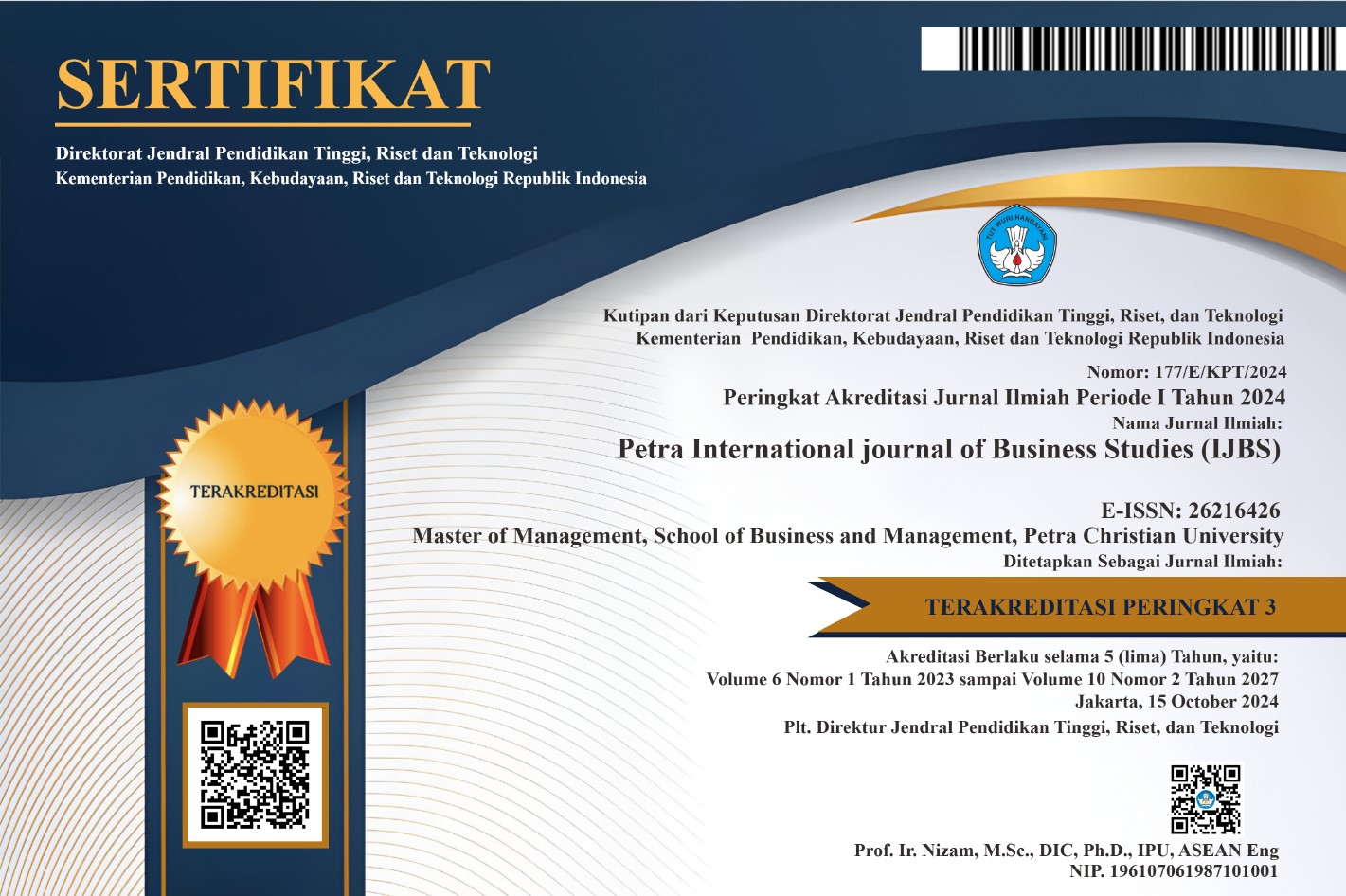The Effect of Marketing Capability on Financial Performance with the mediating role of Perceived Sevice Quality and the moderating role of Competitive Intensity. An empirical study on the Banking Sector in Indonesia
DOI:
https://doi.org/10.9744/ijbs.1.2.80-88Keywords:
Marketing Capability, Perceived Service Quality, Competitive Intensity, Financial PerformanceAbstract
This research aims to analyze the effects of Marketing Capability towards Financial Performance with Perceived Service Quality as Variable Intervening and Competitive Intensity as Variable Moderating at Banking Company in Indonesia. This research was conducted by distributing questionnaires to 170 respondents who are a customer of Bank. Quantitative analysis with path analysis model method was used for the technical analysis. The results of this research shows that the effect of Marketing Capability on Financial Performance is not significant, but the role of the Perceived Service Quality as an Intervening Variable, is able to strengthen the influence of Marketing Capability on Financial Performance to be a significant influence, and Competitive Intensity as a moderating variable on the relationship of Marketing Capability to Financial Performance does not have a significant effect but has a significant direct effect on Financial Performance.
Downloads
References
Apriyani. (2017, 24 maret). “Top 10 Bank 2016”. 26 november 2017, http://infobanknews.com/top-10-bank-2016
Auh,Seigyoung., & Bulent, Meguc. (2005). “Balancing exploration and exploitation: The moderating role of competitive intensity”. Journal of Business Research, 58, 1652-1661
Behrens, Christiaan. Lijensen, Mark. (2015). “Measuring competition intensity; an application to air/hsr transport markets”. Transportation Research Part E: Logistic and Transportation Review. 99, 1-13.
Brady, M. K., & Cronin, J. J. J. (2001). Some new thoughts on conceptualizing perceived service quality: a hierarchical approach. Journal of Marketing, 65(3), 34–49. http://doi.org/10.1509/jmkg.65.3.34.18334
Day, G. S. (1994). The of Market-Drive Capabilities Organizations, 58(4), 37–52.
Ernawati. (2017, 23 maret ). “OJK Sebut Kondisi Perbankan Indonesia Stabil dan Cenderung Membaik”. 26 november 2017, http://banjarmasin.tribunnews.com/2017/03/23/ojk-sebut-kondisi-perbankan-indonesia-stabil-dan-cenderung-membaik
Gay, L. R & Diehl, P. L. (1992) research Methods for Business and Management. Mc. Millan Publishing Company, New York.
Kamboj, Shampy., Goyal. Praveen., &Rahman Zillur. (2015). A resource-based view on marketing capability, operations capability and financial performance: An empirical examination of mediating role. Social and Behavioral Science, 189, 406 - 415
Kasmir. (2008). Manajemen Perbankan. Jakarta: PT Grafindo Persada
Katchova, Ani L., & Enlow Sierra J. (2013). Financial performance of publicly-traded agribusinesses. Agricultural Finance Review, 73, 58-73.
Kwieciński, Dariusz. (2016). Measures of Competitive Intensity – Analysis Based on Literature Review. Journal of Management and Business Administration. Central Europe, 25, 53-77.
Lee, H., Lee, Y., & Yoo, D. (2000). The determinants of perceived service quality and its relationship with satisfaction. Journal of Service Marketing, 14(3), 217–231.
Malhotra, N. K. (2004). Marketing research: an applied orientation (4th Editio). New Jersey: Upper Saddle River.
Morgan, N. A., Slotegraaf, R. J., & Vorhies, D. W. (2009). Intern . J . of Research in Marketing Linking marketing capabilities with pro fit growth. International Journal of Research in Marketing, 26(4), 284–293.
Sugiyono. (2009). Metode penelitian bisnis : pendekatan kuantitatif, kualitatif, dan R & D (Cetakan 14). Bandung: Alfabeta.
Theodosiou, M., Kehagias, J., & Katsikea, E. (2012). Industrial Marketing Management Strategic orientations , marketing capabilities and firm performance : An empirical investigation in the context of frontline managers in service organizations. Industrial Marketing Management.
Undang - Undang Perbankan no 10 tahun 1998
Vorhies, D. W., & Morgan, N. A. (2005). Capabilities for Sustainable, 69(January), 80–94. Brady, M. K., & Cronin Jr, J. J. (2001). Conceptualizing Perceived Service Quality : A Hierarchical Approach, 65(July), 34–49.
Yoo, D. K., & Park, J. A. (2007). Perceived service quality. International Journal of Quality & Reliability Management, 24(9), 908–926.
Additional Files
Published
Issue
Section
License
Petra IJBS (e-ISSN: 2621-6426) is published by Master of Management program, School of Business and Management, Petra Christian University, Indonesia (MM SBM PCU).












